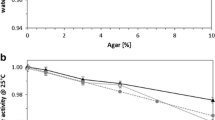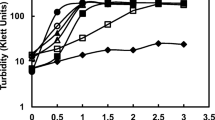Summary
Interaction between salt and sugar receptions in plasmodium ofPhysarum polycephalum was studied by using double-chamber method. Effect of sugars on salt reception was evaluated by measuring membrane potential and the motive force of tactic movement of the slime mold, where salt concentration in one compartment was increased successively with a fixed sugar concentration. Results are summarized as follows: (1) The presence ofd-glucose,d-mannose,d-maltose, or sucrose in medium led to increase of the threshold concentration,C th , for salts (chlorides and nitrates of Li, Na, K), whereasd-ribose decreased the threshold for salt reception.d-galactose showed no appreciable effect onC th of every salt species examined. No change inC th for salt reception was observed until concentration of sugars exceeded their respective thresholds. (2) Double logarithmic plots ofC th for salts against sugar concentration followed different straight lines for different cations, whose slopes being closely correlated with the effects of lyotropic number of anions in the absence of sugars. (3) Plots of logC th against the reciprocal of the absolute temperature, 1/T, gave linear relations, and the slopes of the straight line became small with increase of sugar concentration above their respective thresholds.
Experimental results obtained here suggest that the structure of water at the interface of cell membrane plays an indispensable role in the interaction between salt and sugar receptions.
Similar content being viewed by others
References
Beidler, L.M. 1954. A theory of taste stimulation.J. Gen. Physiol. 38:133
Beidler, L.M., Fishman, I.Y., Hardiman, C.W. 1955. Species differences in taste responses.Am. J. Physiol. 181:235
Camp, W.G. 1936. A method of cultivating myxomycete plasmodia.Bull. Torrey Bot. Club 63:205
Diamond, J.M., Wright, E.M. 1969. Biological membranes: The physical basis of ion and nonelectrolyte selectivity.Annu. Rev. Physiol. 31:581
Franks, F., Ranvenhill, J.R., Reid, D.S. 1972. Thermodynamic studies of dilute aqueous solutions of cyclic ether and simple carbohydrates.J. Solu. Chem. 1:3
Kamiya, N. 1942. Physical aspects of protoplasmic streaming.In: “The Structure of Protoplasm. W. Seifriz, editor. pp. 199–244. Iowa State University Press, Ames
Kamiya, N. 1959. Protoplasmic streaming. Protoplasmatologia8 (3a):1
Tait, M.J., Suggett, A., Franks, F., Ablett, S., and Quickenden, P.A. 1972. Hydration of monosaccharides: A study by dielectric and nuclear magnetic relaxation.J. Solu. Chem. 1:131
Ueda, T., Kurihara, K., and Kobatake, Y. 1975. Response ofNitella internodal cell to chemical stimulation: A model for olfactory receptor system.J. Membrane Biol. 25:271
Ueda, T., Terayama, K., Kurihara, K., and Kobatake, Y. 1975. Threshold phenomena in chemoreception and taxis in slime moldPhysarum polycephalum.J. Gen. Physiol. 65:223
Voet, A. 1939. Quantitative lyotropy.Chem. Rev. 20:169
Author information
Authors and Affiliations
Rights and permissions
About this article
Cite this article
Terayama, K., Ueda, T., Kurihara, K. et al. Effect of sugars on salt reception in true slime moldPhysarum polycephalum . J. Membrain Biol. 34, 369–381 (1977). https://doi.org/10.1007/BF01870309
Received:
Revised:
Issue Date:
DOI: https://doi.org/10.1007/BF01870309




